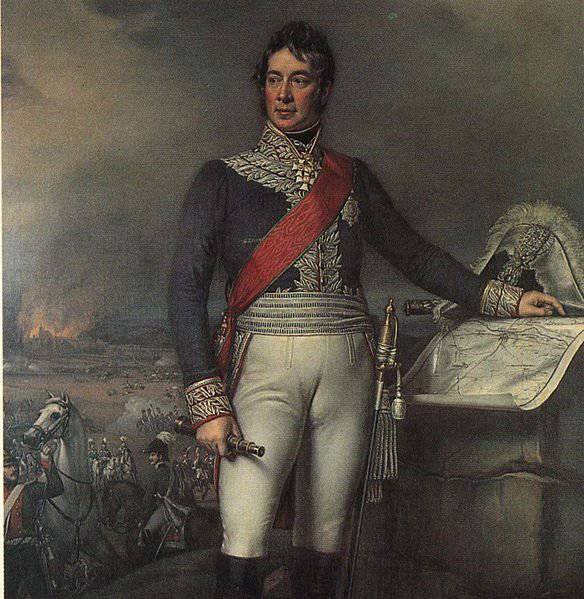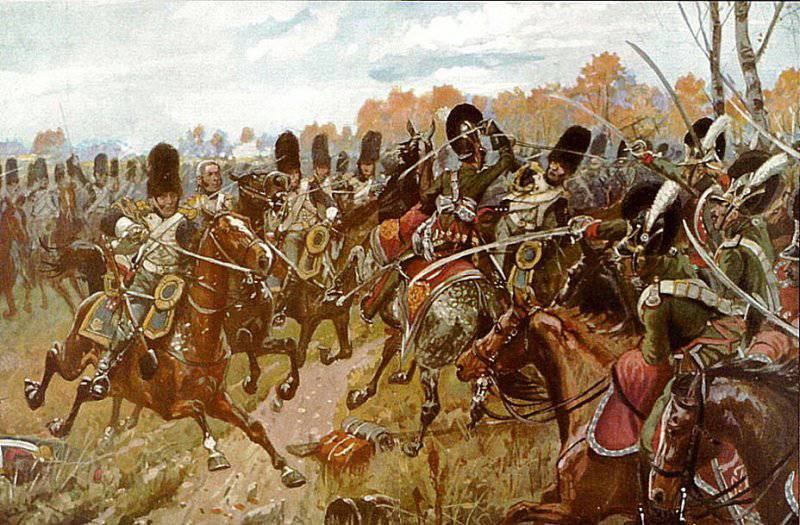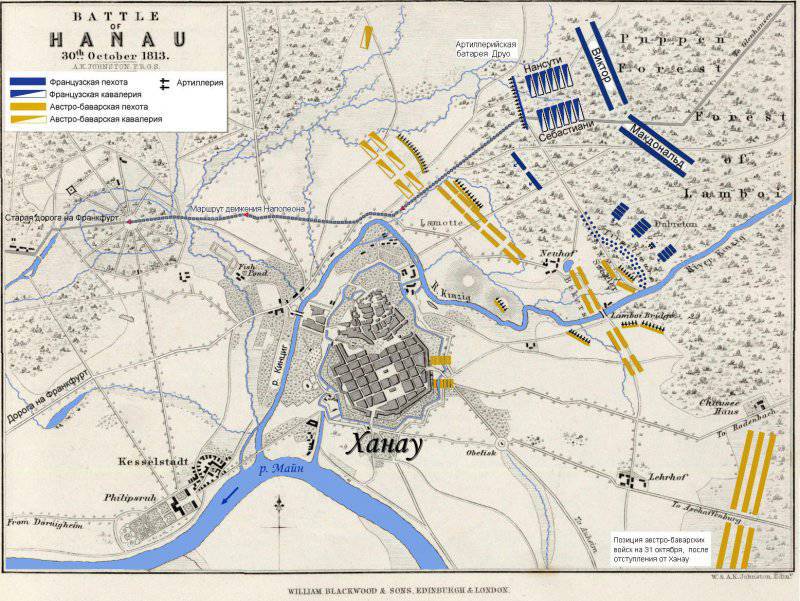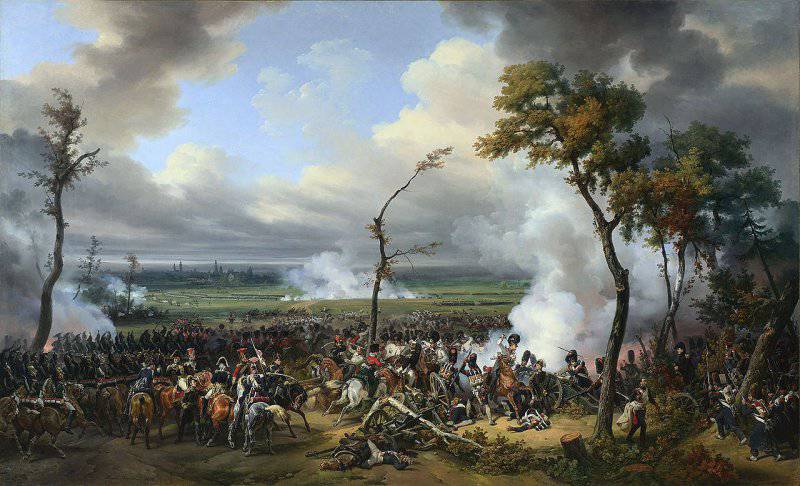Last major battle of the 1813 campaign of the year - Hanau Battle
prehistory
Napoleon's army, after a heavy defeat in the “Battle of the Nations”, retreated by the shortest route to Frankfurt to the Rhine, to France. Allied forces pursued the French. Thus, the Russian General Alexander Rudzewich (from Blucher’s army) captured two thousand enemy soldiers in the city of Gotha.
Shortly before the battle of Leipzig, Bavaria was deposited from the alliance with France. The largest state of the Rhine Union, the Kingdom of Bavaria, owed much to Napoleon, and the preceding wars of the Bavarians often helped the French against their old enemies, the Austrians. However, in the Russian campaign 1812, Bavaria had to pay a high price for an alliance with Napoleon’s empire - 25-thousand. The Bavarian contingent almost completely died in Russia. In the 1813 campaign of the year, Bavaria sent an 10 ths squad to help Napoleon. Many families lost their loved ones and hated France, but Bavaria remained an ally of Napoleon until the last moment, fearing for their land, which they took from Austria. In addition, the policy of Bavaria was determined by the supporter of the alliance with France, Minister Mongelas.
Russian Emperor Alexander Pavlovich and Austrian Chancellor Metternich were able to dispel the doubts of the Munich cabinet. On September 26 (October 8), a convention was signed in Reed, in which the Austrian government vouched for the integrity of the Bavarian possessions and promised a reward if part of the territories were returned to Austria. Munich pledged to break the alliance with Paris and put up its troops to help the anti-French forces. On October 2 (14), Bavaria declared war on France. The next day, the Bavarian troops teamed up with the Austrian corps under the command of Field Marshal Lieutenant (historical military rank in Germany, approximately corresponding to the modern rank of Lieutenant General) Fresnel. The general command of the troops was carried out by the Bavarian prince Wrede. The Allied Austro-Bavarian army consisted of approximately 50 thousand bayonets and sabers with 116 guns. The Bavarian troops had 22,2 thousand infantry (30 battalions), 3,5 thousand cavalry (31 squadrons), 11 artillery batteries; Austrian - 19,8 thousand infantry (18 battalions), 4,3 thousand cavalry (36 squadrons), 7 batteries, engineer and sanitary companies.
Combined Austro-Bavarian troops headed to intercept the line of retreat of Napoleon. The 12 (24) of October both Austrian infantry divisions with the 2 Bavarian Division and the 2 Cavalry Brigade besieged the city of Würzburg. The city commandant divisional general Taro refused to capitulate. The city was shelled. An assault was assigned to 14, but Taro surrendered the city and retreated to the Marienberg citadel. Three Austrian battalions were left to guard the city and blockade the citadel. The rest of the troops went to Ashafenburg, there 16 of October all the forces of Wrede were concentrated.
The headquarters of the commander-in-chief of the Allied forces Schwarzenberg suggested that Wrede took the path of the retreat of Napoleon's troops to Frankfurt, or to Fulda. Wrede was deceived, the general believed that the main forces of Napoleon’s army were retreating north on the road to Koblenz or to Bonn, that only the flank corps of 20 thousand men moved from Fulda to Frankfurt. Wrede decided to intercept the enemy corps and moved to Hanau, which was located 20 km east of Frankfurt at the mouth of the Kinzig River, which flows into the Main. Both of these rivers skirted Hanau, Kinzig - from the north, and navigable Mine - from the south, merging on the western border of the city. The old road to Frankfurt ran along the north (right) bank of Kinzig. Hanau stood on the left bank.
On the morning of October 16 (28), the Bavarian light-mounted regiment unexpectedly broke into Hanau for the enemy and captured the Italian general, Santa Andrea, and many prisoners. Then the Bavarian cavalry moved on, but 3, a thousand detachment of the French reserve, was confronted under the command of General Gruvel. The Bavarians withdrew after Hanau, but at the approach of the 3-th Bavarian division of La Motta, they again occupied the city, capturing the 500 people. The 17 (29) of October, another French reserve column under the command of General Guérin, numbering about 4 thousand, tried to retake Hanau, but was reflected. On the same day, the main forces of Wrede arrived at Hanau. Russian cavalry detachments — Kaisarov, Chernyshev, Orlov-Denisov, Ilovaisky, and the Austrian detachment of Mensdorf — also arrived here. Wrede directed the 1 Bavarian division of Count Rechberg to Frankfurt (Hanau left 43 thousand soldiers).
In the avant-garde was appointed 3-I Bavarian division. She took Langenzebold and settled between this place and the forest, making positions for two batteries. The Austrian Volkmann brigade, reinforced by the 3 th Chasseurs battalion, the Uhlan and Hussars, was directed by the forest to the right flank, towards Alzenau. At 3 o'clock in the afternoon, the advanced French forces — two divisions of the Young Guard, the 11 Corps and a large part of the cavalry, came to Langenzebold. The French seized the town, pushing the Bavarian troops back. Volkmann's squad also entered the battle with the enemy, made several successful attacks, but with the order of Wrede - not to get involved in a decisive battle, he withdrew. Under the cover of cavalry, the Allied forces withdrew.
On the night of 17 on 18 (29-30) of October, the allied army took the following positions: 3-I division of La-Motta and Austrian Volkmann brigade at Ryukingen, 2-I Bavarian and 1-I of the Austrian division before you, and NNXX-Bavarian 2-Austrian brigade in front of Hanau; one brigade of the Austrian XNUMX Division occupied the city; another brigade of this Austrian division with the Austrian cavalry was located in front of the Nuremberg outpost, on the road to Ashafenburg. Wrede still thought that before him was part of the French army and held a purely defensive position in the hope of detaining the enemy until the main forces of the allied army arrived. In the morning he had already assumed that he was facing significant enemy forces. But he decided to fight, knowing that the French armies were followed by the Allied armies, which could inflict a final defeat on Napoleon.

Karl-Philip von Wrede (1767 - 1838)
Battle
The course of the battle 18 (30) October. In the morning of October 18 (30), Wrede deployed the troops as follows: the right wing, which consisted of Becker’s 2 Bavarian Division, on both sides of the Kinzig River, from the Neygof manor to the highway; The 2-I Austrian Grenadier Brigade of Count Klenau was located in reserve, behind the Lambaus Bridge; in the center was the Austrian Bach Division and the 3-I Bavarian La Motta Division, retreating from Rukingen, 50 guns under the command of the Austrian general Strotnik were facing forward against the exit from the forest; the left wing, of the Austrian-Bavarian cavalry, was built in several lines, between the old Gelgausen road and the forest. Behind the left flank were Russian partisans (volatile army cavalry units). The Austrian grenadier brigade of Dimar occupied Hanau.
Napoleon, having learned about the presence of Wrede, decided to oppose him without fear of counterattacks of his former subordinate (the Bavarian general led the division led by Napoleon in the Russian campaign 1812 of the year). Oboz, wounded, sick and unarmed, under the guise of the 3 of the cavalry corps, Napoleon sent along a country road from Langenzebold to Bergen towards Mainz. The emperor himself, at dawn 18 (October 30) spoke on the main road. MacNonald Corps 11 and Sebastiani's cavalry followed the Old Guard and the troops of Victor, Marmont and Bertrand. Udine could only come in the evening. At the beginning of the battle, Napoleon had about 17 thousand people on hand, 19 (31) of October had grown to 60 thousand soldiers.
At 8 in the morning, MacDonald and 2, thousands of people, attacked the advanced forces of the La Mott division at Rukingen. Bavarians stubbornly defended until 10 hours. MacDonald was forced to deploy the Charpentier Infantry Division and the Exelman Division (Sebastiani Cavalry Corps) against them. After that, the Bavarians in full order went to Hanau. The French quickly followed them through the Lambaan forest and reached the main position of the allied forces by noon. Here they were stopped by artillery fire. Napoleon ordered General Dubreton, with 2, thousands of shooters of the 2 corps and several guns to strike the right wing of the enemy. Here the battle lasted for a long time with varying success, but the French could not get out of the forest.
Napoleon sent the commander of artillery, General Louis Antoine Drouot, his French emperor called "the first officer of his kind weapons”, To study the battlefield to find out whether it is possible to shake the enemy’s positions with the help of artillery. Drouot discovered in the forest the way for the supply of 50 guns of the Guards artillery with a cover of two Guards battalions to the left flank of Wrede. Napoleon with Drouot, Kolenkur and with several officers himself studied the terrain and approved the decision of the artillery commander.
Guards battalions occupied the edge and strong shooting forced the Austrian-Bavarian artillery to move back. Then the guns were taken out of the forest. Wrede threw cavalry against her, but she was met by a card-gun volley and the cavalry and corps of Sebastiani — the division of Saint-Germain and Exelman — moved in the attack. The French cavalry immediately overturned the upset Austro-Bavarian cavalry, began to chop down the artillery servants and moved on the infantry, seeking to completely break through the enemy’s defensive orders. But, despite the superiority of the French cavalry, the Austro-Bavarian cavalry managed to reorganize and launch a counterattack, while at the same time a faction of Chernyshev struck the French. The French retreated, the allies pursued them, but after being met with a shotgun volley from 50 guns, they withdrew.
R. Knotle. Bavarian cavalry and equestrian grenadiers of Napoleon’s imperial guard in the battle of Hanau 30 in October 1813.
The Austro-Bavarian artillery, unable to resist the French artillery, consumed a significant part of the charges and lost a significant part of the servants, so Vrede began to withdraw troops across the Kinzig River. The retreat of the center and right flank was difficult. The Lambuasky bridge was narrow, the railing was fragile, as a result, many people fell into the water and sank in the waters of this deep river. The troops of the left flank retreated along the Kienzig bridge and further through the city. Wrede took a new position on the road from Hanau, leaning his left flank on the Main and covering the right flank with a dense forest. A battery with a cover was left at the Lambouisky bridge, there were three batteries in the city.
Hanau 18 (30) October 1813 Battle Scheme
The course of the battle 19 (31) October. At night, the city was bombarded with explosive shells, fires occurred in several places. In the morning the troops of Marmona attacked the Lambouis Bridge, the dam at Gerren-Mühle and the Kinzig Bridge. The French were able to capture only the Kienzig bridge, and Wrede ordered to clear Hanau. Napoleon occupied part of the forces with the city, while the rest of the forces continued to retreat to Frankfurt, along the highway and the side road to Bergen.
By 11 hours most of the French troops passed Hanau. Napoleon followed with guards. He entrusted command of the remaining troops to Marmont and Bertrand. About one o'clock in the afternoon, Marmon with the 3 and 6 bodies also moved to Frankfurt. The city’s defense was assigned to Bertrand with the 4 Corps: the Fontanelli division occupied the city, the Guillemino division was located at the Lambouis bridge, the Moran division was in reserve. For several hours the battle was limited to a gunfight and artillery fire.
At 2 in the afternoon, General Wrede, having learned about the withdrawal of most of the enemy troops, decided to go on the attack. He wanted to hit the French from several sides. Therefore, he ordered the 32 guns to be sent to the Lamboua bridge in order to transfer part of the troops to the right bank of Kinzig under cover of their fire. He himself headed the 6 of the Austrian battalions and hit the city from the side of the Nuremberg outpost. Wrede first descended into the moat and climbed the wall. The blow was unexpected. The French, after some resistance. ran across the Kinzig bridge. Many officers and lower ranks were captured, including two generals.
Wrede at the head of the column rushed to capture the bridge, but was seriously wounded. The army was led by Austrian Field Marshal Lieutenant Fresnel. Bavarians, angry at the loss of their leader, rushed to the attack, along with the Austrians. The division of Moran, who came to the aid of his comrades, could not hold back the fierce onslaught of the enemy and withdrew from the bridge with heavy losses. In this battle, the brave generals Lejeune and Gulo, who fought in the brow of the 8-th lung and 23-th French regiments, fell to death. The French retreated, but managed to burn the bridge. Austrian-Bavarian troops were forced to stop. Only the Austrian hussars forced the river and captured a significant number of prisoners.
The right wing of the Vrede army was able to cross the Lambaan bridge only in the evening. Taking advantage of this, Bertrand's troops retreated to Frankfurt. French troops pursued the Cossacks Platov, cavalry detachments (partisans) of Chernyshev, Ilovaisky 12, Orlov-Denisov and Kaysarov. They walked well in the enemy’s rear, captured up to 3 thousand people.
1-I Bavarian division Lieutenant-General J. Rechberg-Rotenleva, which occupied Frankfurt, when it detected the movement of superior enemy forces, retreated to the left bank of Mainz, to Saxengausen. Bridges tried to destroy. The French attempt to cross the arm was repelled.
G. Vernier. Battle of Hanau
Results
An attempt by the Austrian-Bavarian troops under the command of Wrede to stop the enemy’s movement, in the hope of a quick arrival of the main forces of the allied army, failed. Both sides attributed the victory to themselves. The French, on the first day of the battle, captured the positions of the Wrede army, forcing it to retreat, and made their way to the Rhine with weapons. The allies on the second day of the battle repulsed Hanau, forced the French to retreat and, pursuing the enemy, captured many prisoners. But, given that the Allies wanted to stop the French army, and the French wanted to break through to the Rhine, saving the remnants of the army, it is obvious that Napoleon won the victory.
Napoleon again, as in the Berezina, managed to avoid a fatal blow, but it should be noted that in both cases he was lucky. The command of his opponents was constantly mistaken, giving good chances of salvation. And Napoleon, being a truly gifted commander, did not miss these chances. If the Allied forces, after the victory at Leipzig, were pursuing the French decisively and relentlessly, then the actions of the Wrede army could lead to a decisive victory (possibly final). The army of Napoleon, constrained on all sides by Hanau, could suffer a crushing defeat.
French troops, according to Russian data, lost up to 15 thousand killed and wounded in this battle (according to other sources, Napoleon’s army lost half as many soldiers as Austrians and Bavarians). Allied forces, including Russian partisan detachments and Cossacks, captured more than 10 thousand prisoners, to a large extent these were lagged and sick, soldiers who lost their combat capability. 280 officers and four generals, Santa Andrea, Meroni, Avezani and Martel, were captured. A large number of prisoners is explained by the general disorder of Napoleon’s army. The French army suffered more losses from disease and desertion than from direct hostilities. Austrian-Bavarian lost about 9 thousand people killed, wounded and missing.
October 21 (November 2) Napoleon with the troops crossed the Rhine. The next morning, Frankfurt left the French rearguard. The riders of Orlov-Denisov overtook the enemy from Bergen and beat off the 2 guns, taking 1,5 thousands of people prisoner. Cossacks Platov attacked the enemy at the villages of Wickert and Gochheim.
The Austrians wanted the emperor Franz to be the first at the head of the troops to enter Frankfurt, so their headquarters sent the Russian-Prussian army Barclay de Tolly from the right wing of the Bohemian army to the left. The Austrian troops were on their way to Frankfurt by the shortest route. However, Alexander Pavlovich, himself a well-known deceiver, did not let himself be outwitted. He led the Russian-Prussian Guards cavalry by reinforced marches (50 versts per day) arrived in Frankfurt on the eve of the solemn entry into the city of the Austrian emperor. October 24 (November 5) The 1813 of Frankfurt, in full parade, included the Light Guards Cavalry Division, the 12 Russian Cuirassier Regiments and the Prussian Guards Cavalry. The next day, Alexander met the Austrian monarch already as the owner of the city.
Allied forces stopped at the border of France, putting themselves in order. The Hanau battle was the last major battle of the 1813 campaign of the year. The last insignificant affair of the 1813 campaign took place on October 24 (November 5) near Frankfurt, where Austrian troops under the command of Field Marshal Schwarzenberg broke the garrison of General Bertrand from Hochheim. The 1813 campaign ended for Napoleon with complete defeat, he lost most of Europe, continuing the struggle only in Spain and Italy.



Information